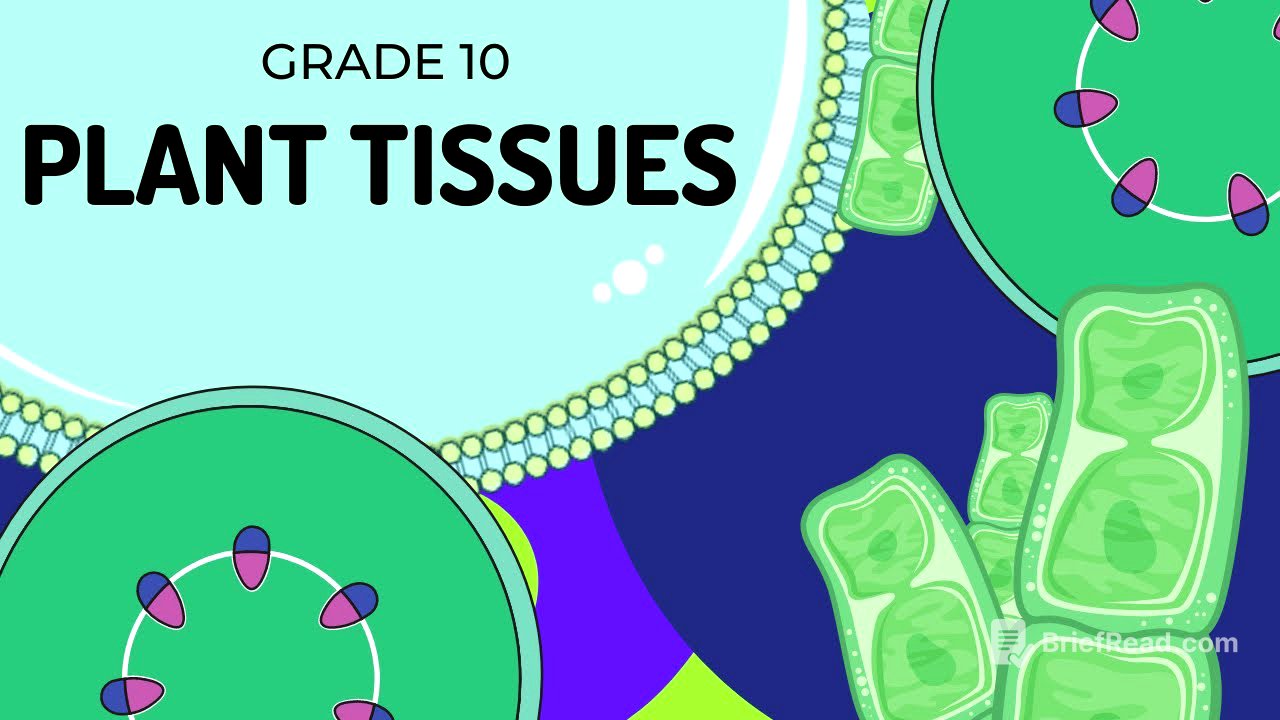TLDR;
This video provides a comprehensive overview of plant tissues, focusing on identification, function, and microscopic appearance. It covers meristematic and permanent tissues, including parenchyma, collenchyma, sclerenchyma, xylem, and phloem. The video also explains the roles of apical and lateral meristems in primary and secondary growth, as well as specialised epidermal tissues like stomata and root hair cells.
- Meristematic tissues are temporary and responsible for plant growth, differentiating into permanent tissues.
- Permanent tissues include epidermis, ground tissues (parenchyma, collenchyma, sclerenchyma), and vascular tissues (xylem, phloem).
- Specialised epidermal cells, such as stomata and root hair cells, perform specific functions like gaseous exchange and nutrient absorption.
Introduction to Plant Tissues [0:00]
The video introduces the topic of plant tissues, promising to simplify their identification and functions for exam preparation. It aims to show what these tissues look like under a microscope, helping students recognise them in diagrams and micrographs. The content is tailored for Life Sciences students in grades 10 to 12.
Meristematic Tissues: Apical vs. Lateral [0:50]
Plant tissues are divided into meristematic and permanent types. Meristematic tissues are temporary and responsible for growth, eventually differentiating into permanent tissues. These tissues are found in two main regions: apical (tips of shoots and roots) and lateral (in the stem). Apical meristems cause primary growth, leading to the lengthening of the plant, while lateral meristems are responsible for secondary growth, increasing the plant's width through the cambium. Lateral meristems also contribute to the formation of bark on trees.
Epidermis: Structure and Specialised Cells [3:13]
The epidermis, a permanent tissue, functions primarily for protection. It includes the cuticle and upper epidermis, with a lower epidermis and cuticle also present. The waxy cuticle prevents water loss, while the epidermis itself is a single cell layer thick to allow maximum sunlight penetration to underlying tissues. Specialised epidermal cells include stomata, which are guarded by guard cells and regulate gas exchange by opening and closing based on vacuole water content. Root hair cells, another specialised type, are microscopic and elongated to increase surface area for nutrient and water absorption, featuring a large vacuole for storage.
Parenchyma: Identification and Function [8:22]
Parenchyma is the most abundant ground tissue in plants. It is identified by its thin cell walls and intercellular airspaces, appearing as irregularly shaped cells in diagrams. Parenchyma functions as packaging tissue, providing sponginess, softness, and flexibility. It also stores substances and facilitates gaseous exchange and water movement through its intercellular airspaces. A special type of parenchyma, chlorenchyma, contains chloroplasts and performs photosynthesis, often found on the surface of green stems.
Collenchyma: Distinguishing Features and Role [10:49]
Collenchyma is similar to parenchyma but can be distinguished by its unevenly thickened corners. These thickened corners provide support and strength due to the presence of cellulose and pectin in the cell walls, while still allowing flexibility. Collenchyma is found in soft, bendy green stems that have not yet transitioned into woody stems, and it contains chloroplasts for photosynthesis.
Sclerenchyma: Types and Functions [12:44]
Sclerenchyma is the thickest of the ground tissues, characterised by evenly thickened walls. Its main function is to provide rigidity and strength, found in roots, stems, and branches. Sclerenchyma is divided into fibres, found in wood and bark, and sclereids, found in nuts and stone fruit. Sclerenchyma is a non-living tissue, with cells that appear to have collapsed cytoplasm.
Vascular Tissues: Xylem for Water Transport [15:08]
Vascular tissues, xylem and phloem, are specialised for transport. Xylem transports water and has elongated, dead, and empty cells with large lumens and cell walls thickened with lignin. It contains pits for lateral water movement and transports water and minerals in one direction, from roots to shoots. Xylem comes in two shapes: vessels (round and elongated, arranged end to end) and tracheids (spindle-shaped, tapered ends, overlapped).
Vascular Tissues: Phloem for Sugar Transport [17:56]
Phloem, similar to xylem, is arranged end to end but contains sieve plates for filtering sugars. Phloem cells have companion cells that provide them with nutrients and energy, as phloem cells lack organelles to maintain an empty space for transport. Phloem transports sugars in two directions, from roots to shoots and from leaves to roots for storage.









